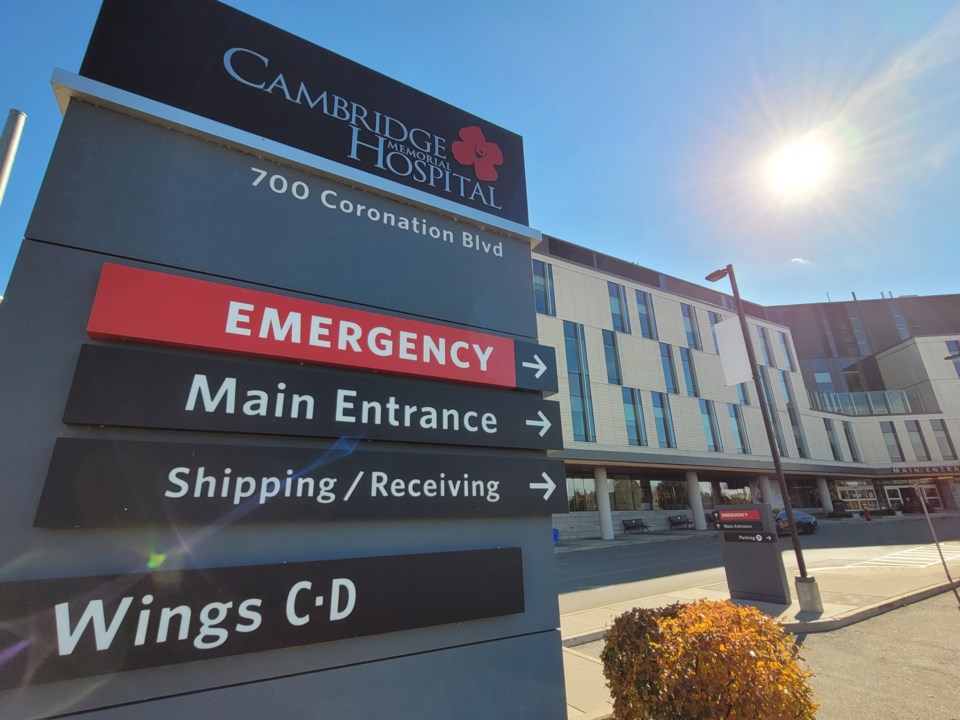Cambridge Memorial Hospital is refuting a social media post made by the local paramedics union that claims 12 ambulances were held up at the hospital this morning due to offload delays, some of which lasted 15 hours.
CUPE5191EMS made the claim in a post on X, formerly Twitter, just before 8 a.m this morning, including photos showing at least six ambulances parked in two bays and areas next to the emergency department.
In response, hospital spokesperson Stephan Beckhoff said he asked around to get a better understanding of the overnight situation at CMH.
"We do not have 12 ambulances on off-load delay, nor has there been that many at one-time over the past 24 hours," he said in an email.
"There have not been any 15-hour waits to the best of our knowledge during the same time span. As always, we work diligently with our EMS partners to transfer patients over to us."
Dave Bryant, who is co-vice-president of CUPE 5191, said he was the one who wrote the post and took the photos, which don't show six additional ambulances parked in various points around the entrance.
12 ambulances on offload delay @_CMHospital . Not a great start to the day. Some offloads up to 15 hours. @_BryanMay @SylviaJonesMPP @fordnation @MaritStiles @CFifeKW @LauraMaeLindo @CTVKitchener pic.twitter.com/16F71iA35j
— Waterloo Region Paramedics (@CUPE5191EMS) November 1, 2023
"We definitely have a different perspective on this," he said in a telephone interview to rebut the hospital's stance and request they be more transparent.
Bryant, who started his shift at 6 a.m. and hadn't eaten by 4 p.m. because of the day's call volume, said seeing 12 ambulances in offload delay is extreme.
But it's not unusual for four to six ambulances to be held up at CMH throughout the day.
During the incident referenced in this morning's post, Bryant said some crews were there on triage delay, offload delay, and there for offload relief.
"Regardless, the culprit is offload delay depleting paramedic services," he wrote in an email. "The purpose of the post was not to blame CMH, but to raise awareness. Our stance is that the fault lies on the provincial government."
A lack of funding from the province to make staff available to mitigate the situation is creating a trickle down effect for paramedics, he said.
In September, the three regional hospitals received $1.6 million from the province to hire more nurses dedicated to offloading patients.
But that effort and other efforts don't appear to be enough to tackle the problem that has led to the code reds and yellows that come when no or few ambulances are available to respond to calls.
The region implemented a Fit2Sit policy this fall to relieve some of those pressures.
It allows paramedics to leave low acuity patients in the emergency waiting room when a bed isn't immediately available.
Other call diversion measures, like a permanent Community Mental Health and Addictions Clinic (C-MAC) at CMH is still awaiting provincial approval.
It would allow patients needing mental health supports to be taken there instead of the emergency department.
Bryant said that while the region has responded with a "dramatic increase" in funding and resources over the last year to help paramedic services deal with rising call volumes, local hospitals continue to fall behind as the region's population grows and ages.
"The problem is very linear," he said. "Hospitals need to play catch up as well and that falls to the provincial government."
@ROWParamedics has hit #codered several times throughout the day today. Currently there are 10 ambulances @StMarysGenHosp . @OntarioPCParty can not keep ignoring this crisis. pic.twitter.com/EnVkunU7zd
— Waterloo Region Paramedics (@CUPE5191EMS) November 1, 2023



